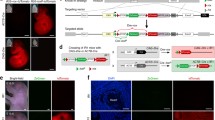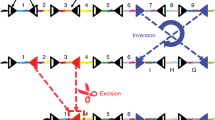Abstract
Cre-responsive dual-fluorescent alleles allow in situ marking of cell lineages or genetically modified cells. Here we report a dual-fluorescent allele, ROSA nT-nG, which directs nuclear accumulation of tdTomato in Cre-naïve lineages. Cre converts the allele to ROSA nG, which drives nuclear EGFP accumulation. Conditions were established for analyzing marked nuclei by flow cytometry on the basis of red–green fluorescence and ploidy, with a particular focus on liver nuclei. Hydrodynamic delivery of a Cre-expression plasmid was used to time-stamp arbitrary hepatocytes for lineage tracing. The distinct green fluorescence of nuclei from Cre-exposed lineages facilitated analyses of ploidy transitions within clones. To assess developmental transitions in liver nuclei, ROSA nT-nG was combined with the hepatocyte-specific AlbCre transgene, facilitating discrimination between hepatocyte and nonhepatocyte nuclei. Nuclei extracted from postnatal day 2 (P2) livers were 41 % green and 59 % red and reached a stable level of 84 % green by P22. Until P20, green nuclei were >98 % diploid (2N); at P40 they were ~56 % 2N, 43 % 4N, and <1 % 8N; and by P70 they reached a stable distribution of ~46 % 2N, 45 % 4N, and 9 % 8N. In conclusion, ROSA nT-nG will facilitate in vivo and ex vivo studies on liver and will likely be valuable for studies on tissues like muscle, kidney, or brain in which cells are refractory to whole-cell flow cytometry, or like trophectoderm derivatives or cancers in which cells undergo ploidy transitions.





Similar content being viewed by others
References
Akagi K, Sandig V, Vooijs M, Van der Valk M, Giovannini M, Strauss M, Berns A (1997) Cre-mediated somatic site-specific recombination in mice. Nucleic Acids Res 25:1766–1773
Blouin A, Bolender RP, Weibel ER (1977) Distribution of organelles and membranes between hepatocytes and nonhepatocytes in the rat liver parenchyma. A stereological study. J Cell Biol 72:441–455
Bohm N, Noltemeyer N (1981) Development of binuclearity and DNA-polyploidization in the growing mouse liver. Histochemistry 72:55–61
Celton-Morizur S, Desdouets C (2010) Polyploidization of liver cells. Adv Exp Med Biol 676:123–135
Duncan AW, Taylor MH, Hickey RD, Hanlon Newell AE, Lenzi ML, Olson SB, Finegold MJ, Grompe M (2010) The ploidy conveyor of mature hepatocytes as a source of genetic variation. Nature 467:707–710
Espanol-Suner R, Carpentier R, Van Hul N, Legry V, Achouri Y, Cordi S, Jacquemin P, Lemaigre F, Leclercq IA (2012) Liver progenitor cells yield functional hepatocytes in response to chronic liver injury in mice. Gastroenterology 143(6):1564–1575.e7
Fung YC (2000) Biomechanics: motion, flow, stress, and growth. Springer, New York
Gehring W (1967) Clonal analysis of determination dynamics in cultures of imaginal disks in Drosophila melanogaster. Dev Biol 16:438–456
Gorski K, Carneiro M, Schibler U (1986) Tissue-specific in vitro transcription from the mouse albumin promoter. Cell 47:767–776
Grompe M (2005) The origin of hepatocytes. Gastroenterology 128:2158–2160
Grompe M, Laconi E, Shafritz DA (1999) Principles of therapeutic liver repopulation. Semin Liver Dis 19:7–14
Gu H, Zou YR, Rajewsky K (1993) Independent control of immunoglobulin switch recombination at individual switch regions evidenced through Cre-loxP-mediated gene targeting. Cell 73:1155–1164
Guo F, Ma J, McCauley E, Bannerman P, Pleasure D (2009) Early postnatal proteolipid promoter-expressing progenitors produce multilineage cells in vivo. J Neurosci 29:7256–7270
Iverson SV, Comstock KM, Kundert JA, Schmidt EE (2011) Contributions of new hepatocyte lineages to liver growth, maintenance, and regeneration in mice. Hepatology 54:655–663
Keng VW, Tschida BR, Bell JB, Largaespada DA (2011) Modeling hepatitis B virus X-induced hepatocellular carcinoma in mice with the Sleeping Beauty transposon system. Hepatology 53:781–790
Kisseberth WC, Brettingen NT, Lohse JK, Sandgren EP (1999) Ubiquitous expression of marker transgenes in mice and rats. Dev Biol 214:128–138
Lu P, Prost S, Caldwell H, Tugwood JD, Betton GR, Harrison DJ (2007) Microarray analysis of gene expression of mouse hepatocytes of different ploidy. Mamm Genome 18:617–626
Malato Y, Naqvi S, Schurmann N, Ng R, Wang B, Zape J, Kay MA, Grimm D, Willenbring H (2011) Fate tracing of mature hepatocytes in mouse liver homeostasis and regeneration. J Clin Invest 121:4850–4860
Mansour SL, Thomas KR, Capecchi MR (1988) Disruption of the proto-oncogene int-2 in mouse embryo-derived stem cells: a general strategy for targeting mutations to non-selectable genes. Nature 336:348–352
Mao X, Fujiwara Y, Chapdelaine A, Yang H, Orkin SH (2001) Activation of EGFP expression by Cre-mediated excision in a new ROSA26 reporter mouse strain. Blood 97:324–326
Melchiorri C, Chieco P, Zedda AI, Coni P, Ledda-Columbano GM, Columbano A (1993) Ploidy and nuclearity of rat hepatocytes after compensatory regeneration or mitogen-induced liver growth. Carcinogenesis 14:1825–1830
Mitchell C, Willenbring H (2008) A reproducible and well-tolerated method for 2/3 partial hepatectomy in mice. Nat Protoc 3:1167–1170
Muzumdar MD, Tasic B, Miyamichi K, Li L, Luo L (2007) A global double-fluorescent Cre reporter mouse. Genesis 45:593–605
Ohtsubo K, Nomaguchi TA (1986) A flow cytofluorometric study on age-dependent ploidy class changes in mouse hepatocyte nuclei. Mech Ageing Dev 36:125–131
Overturf K, Al-Dhalimy M, Ou CN, Finegold M, Grompe M (1997) Serial transplantation reveals the stem-cell-like regenerative potential of adult mouse hepatocytes. Am J Pathol 151:1273–1280
Overturf K, Al-Dhalimy M, Finegold M, Grompe M (1999) The repopulation potential of hepatocyte populations differing in size and prior mitotic expansion. Am J Pathol 155:2135–2143
Ponder E, Ponder RV (1959) Protein concentration in normal mouse lymphocytes, thymocytes, and mouse and human leukemic cells as measured by interference microscopy. J Gen Physiol 42:571–577
Postic C, Shiota M, Niswender KD, Jetton TL, Chen Y, Moates JM, Shelton KD, Lindner J, Cherrington AD, Magnuson MA (1999) Dual roles for glucokinase in glucose homeostasis as determined by liver and pancreatic beta cell-specific gene knock-outs using Cre recombinase. J Biol Chem 274:305–315
Rollins MF, van der Heide DM, Weisend CM, Kundert JA, Comstock KM, Suvorova ES, Capecchi MR, Merrill GF, Schmidt EE (2010) Hepatocytes lacking thioredoxin reductase 1 have normal replicative potential during development and regeneration. J Cell Sci 123:2402–2412
Schmidt EE, Schibler U (1995) Cell size regulation, a mechanism that controls cellular RNA accumulation: consequences on regulation of the ubiquitous transcription factors Oct1 and NF-Y and the liver-enriched transcription factor DBP. J Cell Biol 128:467–483
Sebestyen MG, Budker VG, Budker T, Subbotin VM, Zhang G, Monahan SD, Lewis DL, Wong SC, Hagstrom JE, Wolff JA (2006) Mechanism of plasmid delivery by hydrodynamic tail vein injection. I. Hepatocyte uptake of various molecules. J Gene Med 8:852–873
Severin E, Meier EM, Willers R (1984a) Flow cytometric analysis of mouse hepatocyte ploidy. I. Preparative and mathematical protocol. Cell Tissue Res 238:643–647
Severin E, Willers R, Bettecken T (1984b) Flow cytometric analysis of mouse hepatocyte ploidy. II. The development of polyploidy pattern in four mice strains with different life spans. Cell Tissue Res 238:649–652
Shafritz DA, Oertel M (2011) Model systems and experimental conditions that lead to effective repopulation of the liver by transplanted cells. Int J Biochem Cell Biol 43(2):198–213
Shima A, Sugahara T (1976) Age-dependent ploidy class changes in mouse hepatocyte nuclei as revealed by Feulgen-DNA cytofluorometry. Exp Gerontol 11:193–203
Soriano P (1999) Generalized lacZ expression with the ROSA26 Cre reporter strain. Nat Genet 21:70–71
Srinivas S, Watanabe T, Lin CS, William CM, Tanabe Y, Jessell TM, Costantini F (2001) Cre reporter strains produced by targeted insertion of EYFP and ECFP into the ROSA26 locus. BMC Dev Biol 1:4
Styles JA (1993) Measurement of ploidy and cell proliferation in the rodent liver. Environ Health Perspect 101(Suppl 5):67–71
Suvorova ES, Lucas O, Weisend CM, Rollins MF, Merrill GF, Capecchi MR, Schmidt EE (2009) Cytoprotective Nrf2 pathway is induced in chronically txnrd 1-deficient hepatocytes. PLoS One 4:e6158
Tamura J, Tanaka J, Fujita K, Yoshida M, Kasamatsu T, Arii S, Tobe T (1992) Cell kinetics of regenerating liver after 70 % hepatectomy in rats—2-color flow cytometric analysis. HPB Surg 5:103–114 (discussion 114–105)
Tian JM, Schibler U (1991) Tissue-specific expression of the gene encoding hepatocyte nuclear factor 1 may involve hepatocyte nuclear factor 4. Genes Dev 5:2225–2234
Wagner S, Chiosea S, Nickerson JA (2003) The spatial targeting and nuclear matrix binding domains of SRm160. Proc Natl Acad Sci USA 100:3269–3274
Weisend CM, Kundert JA, Suvorova ES, Prigge JR, Schmidt EE (2009) Cre activity in fetal albCre mouse hepatocytes: utility for developmental studies. Genesis 47:789–792
Zhu HZ, Wang W, Feng DM, Sai Y, Xue JL (2006) Conditional gene modification in mouse liver using hydrodynamic delivery of plasmid DNA encoding Cre recombinase. FEBS Lett 580:4346–4352
Acknowledgments
The authors thank L. Jackiw, J. Hafferman, S. Iverson, K. Thomas, A. Boulet, C. Keller, and the participating Spring-2010 VTMB422 students for their contributions. This work was supported by NIH/NIA grant AG040020 and funds from the Montana Agricultural Experiment Station to EES. Infrastructure support was provided by NIH-COBRE grants GM103394 and GM103500 to Montana State University, and by support from the MSU College of Agriculture and Department of Immunology and Infectious Disease.
Author information
Authors and Affiliations
Corresponding author
Additional information
Justin R. Prigge and James A. Wiley have contributed equally to this work.
Electronic supplementary material
Below is the link to the electronic supplementary material.
335_2013_9469_MOESM3_ESM.tiff
Supplemental Fig. S2. Flow analysis on native mouse liver nuclei. (A & B) Native nuclei were purified from wild-type adult mouse liver, stained with propidium iodide, and analyzed by flow cytometry. In panel A, propidum iodide fluorescence (DNA content) was analyzed by intensity versus peak-width. Intensity showed distinct clustering as a basis of ploidy with roughly 2N increments. Peak-width (X axis) showed that most events in the 6N region of the intensity plot (blue circle) were in wider peaks than events in the 2N, 4N, and 8N region of intensity (boxed and highlighted in red), suggesting that the 6N population were in wider droplets. We interpret this to indicate that the 6N events were predominantly in droplets occupied by more than one nucleus (e.g., a 2N and a 4N, or three 2N, nuclei). The boxed and red-highlighted events in panel A were plotted in panel B to show the distribution of ploidy within this region. 2N, 4N, and 8N events are indicated, showing the relative abundance of the populations. Note that all liver nuclei, including endothelia and other non-hepatocyte cell types are represented here, and all of the non-hepatocyte nuclei will be 2N. (C) Volume of flow cytometry-isolated hepatocyte nuclei as determined by morphometry on slides. DRAQ5- stained nuclei from adult ROSAnT-nG/nT-nG; AlbCre1 mice (hepatocyte nuclei green, other nuclei red) were sorted and the population of green 2N, 4N, and 8N were isolated. Each population was fixed on slides, stained with DAPI, and 150–300 nuclei of each type were analyzed morphometrically. Error bars indicate SEM. (TIFF 824 kb)
335_2013_9469_MOESM4_ESM.tiff
Supplemental Fig. S3. Flow analysis on P175 ROSAnT-nG/+; AlbCre1 mouse liver nuclei. Nuclei were stained with DRAQ5 and analyzed for DRAQ5 fluorescence (DNA content) versus EGFP fluorescence. Hepatocyte nuclei will be green due to expression of AlbCre, whereas non-hepatocyte nuclei will be red. Parameters were as in Fig. 3b of main text. Only two classes of green (i.e., right of black vertical line) diploid nuclei are seen in these cells, and all red (i.e., left of black vertical line) nuclei are diploid (TIFF 706 kb)
Rights and permissions
About this article
Cite this article
Prigge, J.R., Wiley, J.A., Talago, E.A. et al. Nuclear double-fluorescent reporter for in vivo and ex vivo analyses of biological transitions in mouse nuclei. Mamm Genome 24, 389–399 (2013). https://doi.org/10.1007/s00335-013-9469-8
Received:
Accepted:
Published:
Issue Date:
DOI: https://doi.org/10.1007/s00335-013-9469-8




